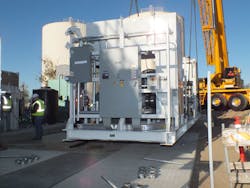1.4-MW Fuel Cell Now Operational at Cal State San Bernardino
The combined heat and power configuration, or cogeneration, that fuel cells provide can help reduce a campus’ carbon dioxide emissions by lessening reliance on high temperature hot water generators. The cells also use natural gas to generate ultra-clean electricity through an electromechanical reaction, greatly reducing combustion-induced unhealthful emissions. For these reasons, a new 1.4-megawatt (MW) utility-owned fuel cell is now in full operation at California State San Bernardino.
A joint project with Southern California Edison, Cal State commissioned a Direct Fuel Cell DFC 1500 power plant to be integrated into the campus’ central plant. The fuel cell will generate electricity to the utility grid with waste heat to the campus at no cost to the university—with an estimated annual savings of $120,000 by avoiding natural gas costs. The fuel cell is highly efficient, generating more power from a given unit of fuel and lowering greenhouse gas emissions in comparison to combustion-based power sources of a similar size.
The cogeneration DFC plant is capable of achieving total thermal efficiencies up to 90 percent, depending on the application. The distributed generation attribute of fuel cells also enables power-generating capacity at the point of use without a commensurate investment in the transmission and distribution grid. This improves energy security by reducing the need to transport electricity from remote sources.
Cal State San Bernardino is the fifth California university to adopt fuel cell integration, representing 8-MW in total power generation capacity. In the spring of 2010, the California Public Utilities Commission authorized Southern California Edison and another California university to pursue utility-owned fuel cell installations on campus, recognizing fuel cells as preferred resources and serving as the catalyst for further initiatives.
More information about the Cal State San Bernardino project can be found here.
About the Author
Iliza Sokol
Associate Content Producer
Iliza joined the Penton Media group in 2013 after graduating from the Fashion Institute of Technology with a BS in Advertising and Marketing Communications. Prior to joining the staff, she worked at NYLON Magazine and a ghostwriting firm based in New York.
